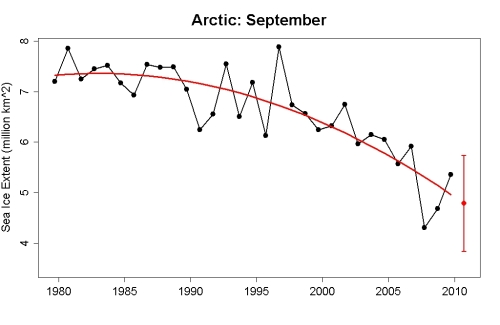Arctic non-shocker: Ever-thinning sea ice melts out as area, extent, and volume approach record lows
Disinformers puzzled by reality, try to game prediction contest
by Joseph Romm, Climate Progress, September 7, 2010In May, I wrote “Arctic poised to see record low sea ice volume this year.” The latest analysis from the Polar Science Center suggests that in fact we are going to break the record of “5,800 km^3 or 67% below its 1979 maximum.”
The anti-science disinformers have been insisting that the ice is getting thicker and, as recently as mid-August, asserted that we would see a ‘recovery’ in Arctic ice to 2006 levels (see “WattsUpWithThat breaks own record for fastest overturning of a prediction by reality“). Not.

That plot is sea ice area from the Japan Aerospace Exploration Agency.
The National Snow and Ice Data Center (NSIDC) tells me that “at this time of year area would be a better indicator of the health of the ice pack than the extent.” NSIDC explains the difference between extent and area here:
A simplified way to think of extent versus area is to imagine a slice of swiss cheese. Extent would be a measure of the edges of the slice of cheese and all of the space inside it. Area would be the measure of where there is cheese only, not including the holes.SEARCH, the Study of Environmental Arctic Change, runs a contest of sorts in which different scientific groups predict the Arctic extent minimum using NSIDC’s numbers. The group average for the predictions made at the end of August was for “4.8 +/- 0.77 million square kilometers.” NSIDC tells me today that the extent is 4.89 (click to enlarge):
While Anthony Watts and Steve Goddard have been insisting pretty much every week for the last month that the melt season was over, it has persisted and, if this were a typical season in the last decade, extent would keep shrinking for another week or so.
While Goddard was insisting as recently as August 22 that “My forecast remains unchanged. 5.5 million, finishing above 2009 and below 2006. Same as it has been since May,” somehow he duped the SEARCH folks into letting him sneak in a different prediction for their August report of 5.1 million:

Well, he’s still going to be wrong, but I guess if you make enough predictions and look around hard enough among the different data sets, eventually somebody somewhere someday may think you know what you’re talking about.
The fact that the ice has kept melting to near-record levels of extent and area is a pretty good sign that the disinformers were wrong about their claim ice thickness had recovered, a claim that was widely disputed by NSIDC and the actual data. It now looks more and more like the PSC’s PIOMAS model is correct:
Daily Sea Ice volume anomalies for each day are computed relative to the 1979 to 2009 average for that day. The trend for the 1979- present period is shown in blue. Shaded areas show one and two standard deviations from the trend.Again, that is a figure of the volume anomaly. If I am reading the 1979 to 2000 average right, it looks like we are already below last September’s volume record, but that will become clearer in about two weeks — and I suspect PSC will take its time in making a final pronouncement.
New Scientist did a very nice version of this, which makes clear we are indeed in a death spiral:

Finally, back in July, Tamino made a prediction of the September sea ice extent minimum using a simple quadratic:

The decline is obvious. What may not be obvious (without the regression line) but is still clear, is that the decline has accelerated. That’s why I’ve fit a quadratic trend line. So here’s a simple projection: I’ve extrapolated the trend line to this year. Which gives a predicted September extent of 4.78 million km^2 (plotted as the red dot on the graph). I’ll call that my forecast for the summer minimum.Looks like he is going to be pretty darn close. The death spiral lives!
Needless to say, if the quadratic trend continues, then I am quite likely to win my bet of a 90% ice free Arctic by 2020 (see “Another big climate bet — Of Ice and Men“).
Link: http://climateprogress.org/2010/09/07/arctic-sea-ice-area-extent-volume-record-low-2/#more-32787









No comments:
Post a Comment